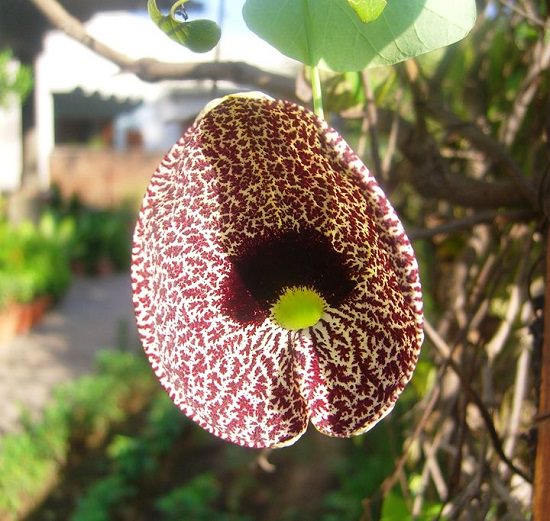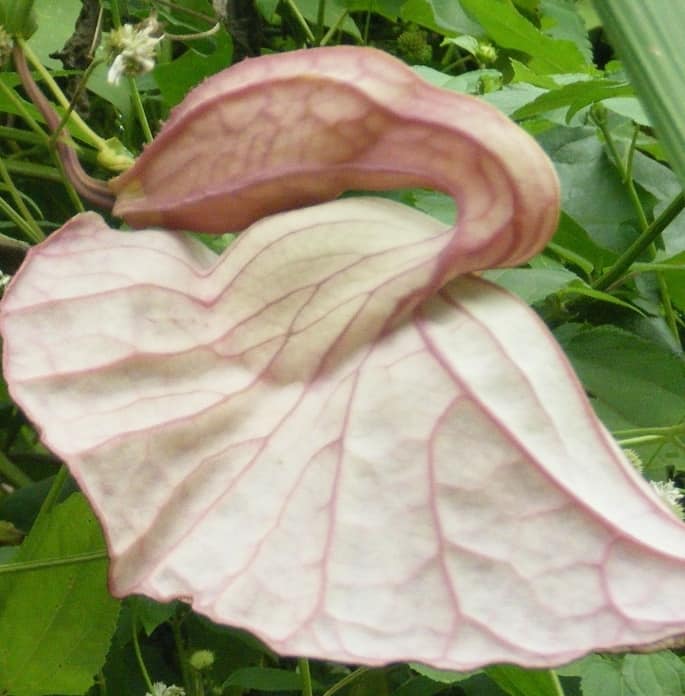Overview
Latin name: Aristolochia trilobata L., Aristolochia spp.
Other names: Flor de Pato, Duck Vine, Duck Flower Plant, Dutchman’s pipe, Pelican flower
Location: Native to central and eastern North America
Plant Description
A plant of the birthwort family, duck flower is one of the world’s largest flowers. It is a deciduous vine with flowers that emits an odour that smells like rotting meat, attracting flies. The flowers are usually purple and white in colour. They are enlarged and circular at the base, extending into thin, soft, papery structures that do not resemble traditional flower shapes. This is due to their unique strategy for pollination, which involves attracting and trapping flies for short periods of time.
The heart-shaped or kidney-shaped leaves are about 15 to 35 cm (about 6 to 14 inches) wide. The yellowish brown or purplish brown tubular flowers resemble a curved pipe and are about 8 cm (3 inches) long. Dutchman’s pipe is a fast growing plant that is often planted as a screen or an ornamental on porches and arbours.
Chemical Composition
Compounds found in the plant include aristolochic acids and esters, aristolactams, aporphines, protoberberines, isoquinolines, benzylisoquinolines, amides, flavonoids, lignans, biphenyl ethers, coumarins, tetralones, terpenoids, benzenoids, steroids, and others.
Medicinal Uses
Traditionally, the plant has been used as an anti-inflammatory agent and for the treatment of snakebites. Duck flower is used medicinally to increase sexual desire; it is used for intestinal pain, gallbladder pain, arthritis, gout, achy joints, rheumatism, eczema, weight loss, and wounds. Recently, it was found to be a contaminant of a weight loss preparation (Vanherweghem, 1998).
Parts Used
Stem, Leaves, Roots.
Uses With Dosage
Excerpt from Messages from the Gods:
Standley and Steyermark (1946) reported that the plant was used in Belize as a local remedy to treat fever. To treat hangover, influenza, colds, constipation, stomach pain, indigestion, flatulence, gastritis (ciro), amoebas, colitis, high blood pressure, “heavy” heartbeat, loss of appetite, scanty or delayed menstruation, and to cleanse the urinary tract, 1 small handful of chopped vine is boiled in 3 cups of water for 10 minutes, strained, and 1 cup consumed warm 3 times daily, before meals, as needed.
If the above ailments are experienced by the weak or aged, the small handful of the chopped vine is soaked (not boiled) in 3 cups of water all day and 1 cup consumed 3 times daily before meals (Arvigo and Balick, 1998). To induce a copious flow of mucus from sinus congestion, one 6-inch piece of vine is soaked in 1 quart of water all day in the sun, sipped over a 12-hour period until all is consumed, and repeated for a second day if necessary [Arvigo and Balick, 1998). As a general tonic and to treat colds, refer to skunk root (Chiococca alba) [Mallory, 1991).
To treat constipation in infants, 1 handful of chopped vine is boiled in 3 cups of water and consumed by the nursing mother [Mallory, 1991). To treat constipation in children, 2 cups of this same decoction are consumed spoonful by spoonful all day until finished [Mallory, 1991). For constipation in adults, 1 cup of this decoction is consumed 3 times daily before meals [Mallory, 1991). To treat bloody dysentery, the root is crushed, boiled in water, and consumed (Arnason et al., 1980).
As a male aphrodisiac reported to be used in the Toledo District, 1 entire plant is chopped, boiled in water, mixed with rum or skunk root, and consumed [Mallory, 1991). As a tonic or stomachic (to stimulate the action of the stomach), 1 entire plantis boiled in water and consumed as needed (Mallory, 1991).
Caution is advised with this plant. Recent research and warnings about the carcinogenic activity of aristolochic acid found in species of this genus strongly suggest that this plant not be used in herbal medicine (Gold and Slone, 2003). Aristolochic acid is considered a potent carcinogen and kidney toxin (Lewis and Alpert, 2000).
Precautions
The active ingredient in aristolochia is aristolochic acid, which is carcinogenic, mutagenic, and nephrotoxic. The rodent intravenous dose that kills 50% of the population (LD50) is 38 to 203 mg/kg. In rats, doses as low as 5 mg/kg for 3 weeks have been associated.
How To Propagate Dutchman’s Pipes
Cuttings: Semi-ripe cuttings in summer.
Other Uses Of Dutchman’s Pipes
Grown for their foliage and flowers.
Reference(s)
Messages from the Gods: A Guide to the Useful Plants of Belize By Michael J. Balick, Rosita Arvigo
https://www.britannica.com/plant/Dutchmans-pipe
https://www.sciencedirect.com/science/article/pii/B9780323029988500160
https://candidegardening.com/GB/plants/0e194440-a37c-4ed2-a129-d74aa2af45ec
https://ucmp.berkeley.edu/anthophyta/paleoherbs/aristolochiales.html
https://www.ncbi.nlm.nih.gov/books/NBK326609/
http://biological-diversity.info/native_aristolochia.htm
https://www.gbif.org/species/7313567
This article is copyrighted by Ital is Vital, 2024. Want to re-post this article? Visit our guidelines.
DISCLAIMER: THIS WEBSITE DOES NOT PROVIDE MEDICAL ADVICE
The information, including but not limited to, text, graphics, images and other material contained on this website are for informational purposes only. The purpose of this website is to promote broad consumer understanding and knowledge of various health topics. It is not intended to be a substitute for professional medical advice, diagnosis or treatment. Always seek the advice of your physician or other qualified health care provider with any questions you may have regarding a medical condition or treatment and before undertaking a new health care regimen, and never disregard professional medical advice or delay in seeking it because of something you have read on this website.

